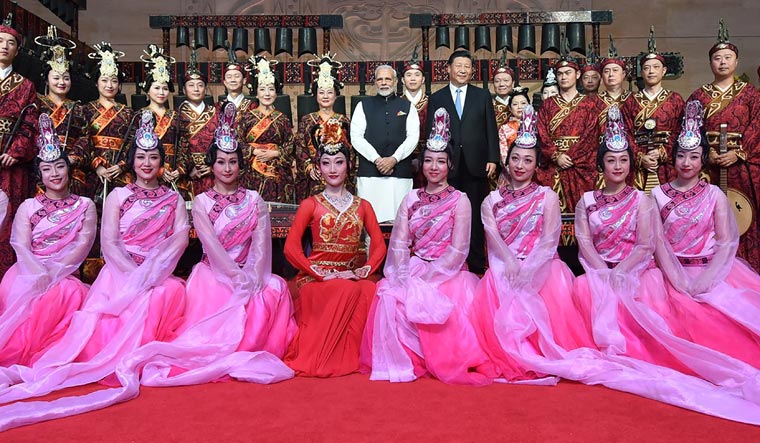The wooing has begun. And the whole world is watching. Prime Minister Narendra Modi and Chinese President Xi Jinping openly courted each other on Friday as they met at the Hublei provincial museum, watched a dance and then went off to talk with interpreters.
The two-day-long informal summit in Wuhan—where the leaders will walk by a river, go for a boat ride and share their views over a cup of tea—is a chance for the two to take time out from the structured format of meetings, to rediscover their understanding. While it might look a lot like couples therapy, the optics of the summit might help bring the temperatures down in both countries.
The Indian and Chinese leaders may not be able to resolve all the issues in this get-away, but Modi and Xi have certainly proved “that the two can talk'' even after a dispute. Trust is the aim of the informal summit. And both sides seem to be clear that this is one area that needs to be addressed.
“Although the relationship between the two militaries still faces some difficulties, we are willing to use the important consensus of the leaders of the two countries as guidance to deepen our understanding, enhance mutual trust, properly settle differences and continue to accumulate the positive energy of the healthy and stable development of the relationship between the two armed forces,'' spokesperson for China's Ministry of National Defence Col. Wu Qian has been quoted as saying.
In the course of the two days, the leaders will meet six times. There will be a dinner hosted by Xi on Friday. On Saturday morning, Modi and Xi will meet again, bright and early, and walk by the East Lake. Post the stroll, there will be an hour-long boat ride, followed by lunch.
Almost the perfect date itinerary, the need for such interaction has been felt on both sides. The proposal came about on the sidelines of the BRICS summit in Xiamen—the first time that President Xi and Modi met post the Doklam incident.
There was a suggestion that there could be a possible meeting between the two on the sidelines of upcoming Shanghai Cooperation Organisation summit, but it was decided that more time was needed for the two leaders to talk. “It is very unusual for both sides,'' said former ambassador to China Ashok Kanta, who now heads the Institute of Chinese Studies. “It is a special gesture for the PM as he goes back for the SCO in six weeks. It is unusual for the Chinese too.”
Months of quiet diplomacy has gone into ensuring that the Wuhan summit came about. Forbidding senior officials from attending the Thank You India events held to mark 60 years of the Tibetan government in exile was a signal by the Modi government that India was keen to show it could be trusted by Beijing. It was in stark contrast to the almost brazen attitude of India to the Dalai Lama’s visit to Arunachal Pradesh that had sparked off the Doklam impasse. There has been a flurry of meetings between India and China this year—a sort of softening of positions.
On Sunday, the day External Affairs Minister Sushma Swaraj announced this informal meeting, the Dalai Lama, at a public lecture in the capital to mark the 60th anniversary of his exile, said Tibet can remain a part of China, if Beijing guarantees the region’s culture and autonomy.
While this position is not new, the repetition of it publicly is no coincidence and is likely to be promoted. The structure of the talks—for India, it is the first time such a format is being explored with China—was still being hammered out even as late as Tuesday.
The question is whether the banks of the Yangzte will be more favourable to love between Modi and Xi than the banks of the Sabarmati.


